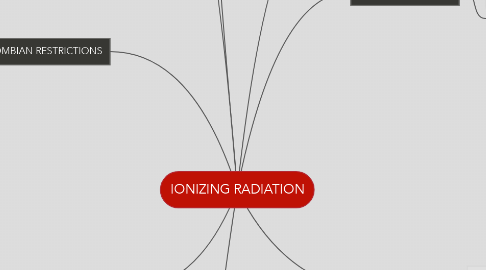
1. WHAT IS IT?
1.1. Ionizing radiation is a type of energy released by the atoms in the form of electromagnetic waves (gamma rays or X-rays) or particles (alpha and beta or neutrons particles). Spontaneous decay of atoms is called radioactivity, and the excess energy emitted is a form of ionizing radiation. Unstable elements that decay and emit ionizing radiation are called radionuclides.
2. MORE SIGNIFICANT INCIDENTS
2.1. The most important accidents of history in the nuclear field, are the explision bombs in Hiroshima, Nagasaki and Chernobyl nuclear reactor, which to date even studies are conducted to determine its true impact.
3. HIROSHIMA Y NAGASAKI
3.1. After more than 70 years of the explosion of nuclear bombs on Hiroshima and Nagasaki, even it occurs among the survivors, inexplicable to medical science pathologies and as they age cases of disease cancer become more evident, so by 2014 nearly two thirds of the population that survived the explocion has died from malignant tumors, highlighting lung cancer, stomach and leukemia
4. RADIATION IN COLOMBIA
4.1. Ionizing radiation is increasingly used in the health sector and in industry; the first has a presence in medical applications, being known varieties of diagnostic studies (Radiology and Nuclear Medicine) and treatments such as radiotherapy, while in industry it is used for energy production, food sterilization, control of insects, to detect manufacturing and assembly errors and to analyze composition of materials.
4.1.1. In Colombia today, there have been no cases of death by radiation, although the number of people suffering from cancer in all types has been in ument, without being challenged even pay enough attention to them, but more than this to their causes.
4.2. In Colombia we can find cases small scale as to what radioactive accidents are concerned, but llegarce to present the most dangerous would be that of the nuclear reactor IAN -R1 that after 16 years of not being put in fuuncionamiento once more was to analyze geological sample on the national territory.
5. COLOMBIAN RESTRICTIONS
5.1. In Colombia there are extensive regulations governing this activity among which are: The Act IX of 1979 the ministry of health, called the national health code, the Labour Code, the resolution 2400 of 1979 of the Ministry of Labour, called the security status. Decree 1988 or 2655 mining code ministry of mines and energy. Resolution 9031 of 1990 the Ministry of Health. Decree 2090 of 2003 the Ministry of Social Protection, unified Circular 2004 the ministry of social protection, resolution 181434 of 2005 the ministry of mines and Decree 1011 of 2006 and 1043 the same year.
5.1.1. Within legal compliances should consider companies with their workers exposed to ionizing radiation we are: Companies in the health sector where procedures that expose workers and users to ionizing radiation are made, must enable the service to the Ministry of Health and Social Protection, previously fulfilling the provisions of Resolution 2003 of 2014. Supply the worker with a dosimeter, which is the instrument to measure the accumulated radiation exposure in a time interval in accordance with the provisions of Resolution 1984 Art 13382 13 2400 Resolution 1979 Art 101. Iimplementar for their workers epidemiological surveillance system, which will identify the adverse health effects from exposure to ionizing radiation and make the case for each track. Pay the worker pension The amount of the special contribution for high-risk activities provided for in Law 100 of 1993, more than ten (10) additional points by the employer under Article 5 of Decree 2090 of 2003. Give 15 days vacation every 6 months as set out in Article 186 of the Labour Code. Workers exposed to ionizing radiation must be updated radiation protection license under the terms of resolution 9031 of 1990 the ministry of health in Articles 11, 12, 13 and 14. All staff handling devices emitting ionizing radiation technology should have professional training, technical or issued by institutions approved by the Ministry of Education, this applies depending on the service provided by the company. The company must provide within working hours, training their workers in the use of machinery, components and substances that emit radiation.
6. Chernobil
6.1. Based on reading, study material, we can infer that in the case of Chernobyl field research on the long-term consequences of radiation exposure, resulted that this can generate changes in human DNA and that these They continued to be introduced, even though it has been 20 years of this incident.
7. IT´S DANGEROUS???
7.1. The damage caused by radiation in the organs and tissues depends on the dose received, or absorbed dose, expressed in a unit called the gray (Gy). The damage that can produce an absorbed dose of radiation depends on the type and sensitivity of different organs and tissues. Beyond certain thresholds, radiation can affect the functioning of organs and tissues, and produce acute effects such as skin redness, hair loss, radiation burns or radiation syndrome acute
7.1.1. But...
7.1.1.1. It is very frequent, prolonged exposures to radiation, lead to cancer suffer in any form.
8. FIELDS OF APPLICATION
8.1. Applications of ionizing radiation in industry are numerous and varied. Thus, they applied in industries such as mining, manufacturing and recycling.
8.1.1. - Meters thickness, density or level. - Treatment processes such as polymerization and sterilization. - Non-destructive testing such as radiography or neutrography. - Tracers, for example for measuring flow rate or fluid velocity in piping. - Prospection, to meet soil characteristics.
